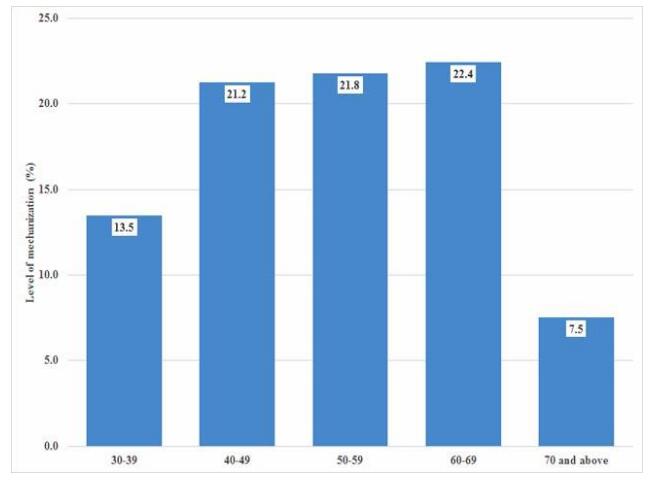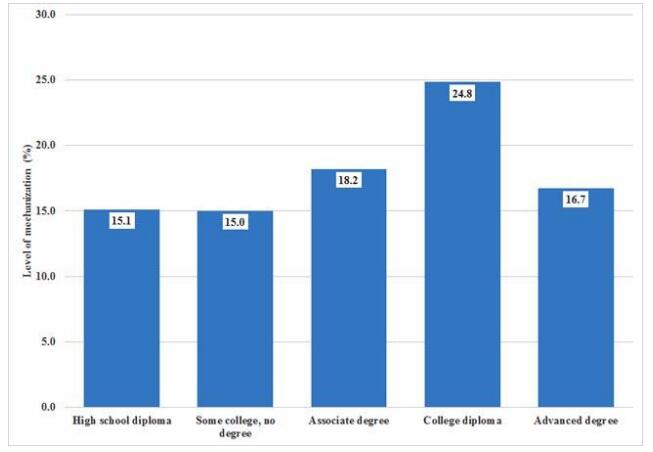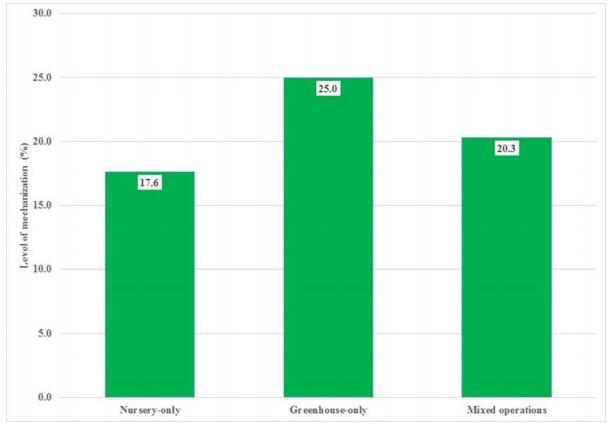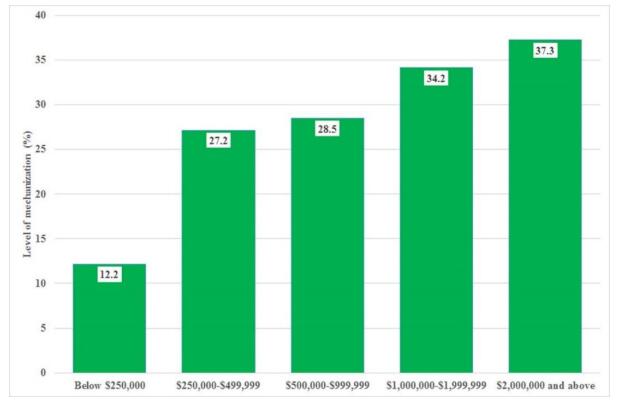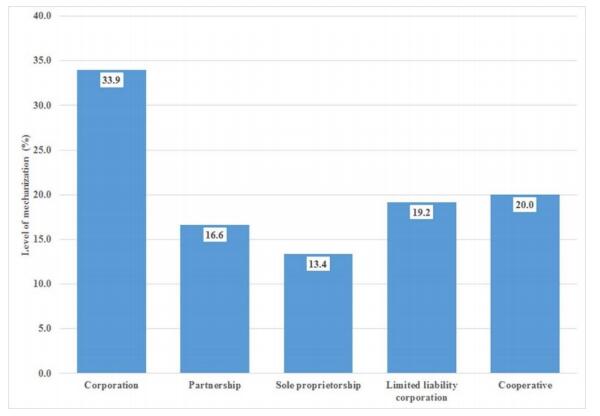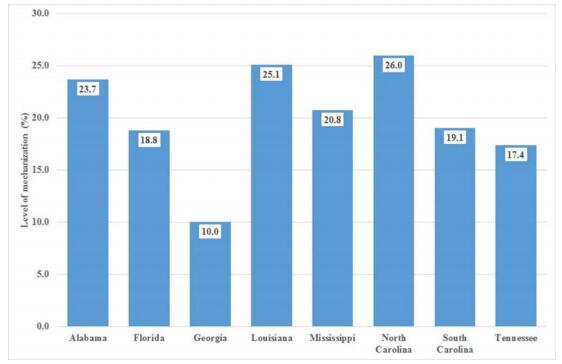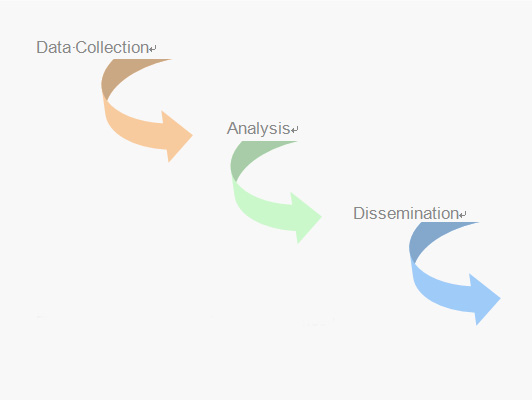1. Introduction
The nursery and greenhouse industry generates significant economic impact on the United States economy. Recent estimates showed that the annual output contribution of the industry amounted to $31.25 billion [1]. The industry also created 240,809 jobs, generated $13.71 billion labor income, and contributed $713 million in business taxes. As the value of horticulture production increases over time, it is expected that nursery and greenhouse growers will improve production efficiency, increase adoption of mechanized or automated production technologies, improve working conditions and workers' safety, and enhance markets for horticulture products.
In eight Southern states, horticultural operations with higher sales employed higher levels of mechanization, implying economies of scale associated with technology adoption by these horticulture production firms [2]. The increase in total workers' earnings related to improved mechanization indicated that these operations were able to pay their workers higher wages and salaries. Improvements in mechanization produced higher values of the marginal productivity of labor.
There was a strong association between annual gross sales and the level of mechanization among participating horticultural firms in eight Southern states during the period under study [2]. This empirical relationship points to the need to identify the factors that influence the decisions by these horticultural operations to mechanize or not to mechanize the tasks performed by their workers. The objective of this paper is to determine the socioeconomic factors that influenced the level of mechanization among nursery and greenhouse operations. It was hypothesized that the level of mechanization in participating nursery or greenhouse operations was determined by their operational characteristics and the socio-demographic characteristics of their owners or operators.
Every horticultural operation seeks to configure the mechanization status that was most appropriate to its operational aspects. Identifying the significant factors enhancing or limiting adoption of technological innovations would improve our understanding of the overall decision-making process involved in the mechanization efforts of nursery or greenhouse operations in the region.
Adoption is a decision to make full use of an innovation as the best course of action available [3]. Conversely, rejection is a decision not to adopt an innovation [3]. The survey of theoretical adoption models and empirical studies of adoption of agricultural innovations in developing countries [4] summarized the explanatory factors affecting adoption as farm size, risk and uncertainty, human capital, labor availability, the credit constraint, tenure, and supply constraints. A recent qualitative study on specialty crop producers explored three main dimensions influencing technology adoption [5] covering technology characteristics, characteristics of users, and environmental context.
In Kentucky, it was postulated that mechanization was determined by labor, farm size, education, age, and land [6]. Results indicated that farm size, labor availability, age and education of farmers have positive effects on mechanization. Human characteristics including producer age and education significantly determined the adoption of sustainable farming practices in West Virginia [7]. Operational characteristics such as firm size and debt-asset ratio did not have any significant influence on adoption. The factors influencing cotton farmers' adoption of the global positioning system (GPS) guidance systems were identified in 11 central and southeastern states [8]. Farmers will likely adopt GPS-based technologies if they are already using other precision-farming techniques and computer for farm management. The adoption of GPS-based technologies is also higher among younger and more affluent farmers.
2. Materials and methods
2.1. Primary data collection
A regional socioeconomic survey of randomly selected wholesale nursery and greenhouse operations was conducted in eight selected Southern states as a part of a research program undertaken by the Mississippi Agricultural and Forestry Experiment Station (MAFES) and the U.S. Department of Labor (DOL) entitled ''Enhancing labor performance of the green industry in the gulf south.'' The survey consisted of eight parts, namely workers' demographic characteristics, nursery characteristics, nursery mechanization, greenhouse mechanization, labor and capital markets, pesticide and chemicals, working conditions, and respondents' characteristics [2,9,14]. The overall goals of the regional socioeconomic survey were to develop a socioeconomic profile of horticulture workers and to evaluate the impact of automation on their employment, earnings, safety, skill levels, and retention rates.
The scope of this work, however, was limited to the socioeconomic determinants of the decisions involved in the mechanization of workers' tasks performed in the industry. Earlier publications using the databases mentioned above collected from Louisiana, Mississippi, and Alabama covered the socioeconomic characteristics of workers and working conditions [10], nursery and greenhouse operational characteristics [11], and socioeconomic impacts of mechanization and automation [2,9]. Additional publications covering all the participating nurseries and greenhouses in eight Southern states included current mechanization systems [12,13], socioeconomic impacts of mechanization and automation [2,9], and hiring preferences [14].
Face-to-face interviews with wholesale nurseries and greenhouses were conducted in eight Southern states—Mississippi, Alabama, Louisiana, Florida, Tennessee, South Carolina, North Carolina, and Georgia from Dec. 2003 to Nov. 2009 [2,9,14]. This length of time was required due to the distance traveled to complete the interviews, the availability of the growers, and the major hurricanes in 2005 and 2008. Official lists of certified nurseries were retrieved from state departments of agriculture or state nursery associations. Only wholesale growers were included in the selection of survey participants.
The wholesale growers in each state included in the survey were identified and numbered from 1 to N [2,9,14]. Using Excel [Office 2003; Microsoft Corporation, Redmond, WA], 50 random integers were individually generated from 1 to N, where N = the number of wholesale growers in each state. Individual letters of introduction were sent to the 50 selected nurseries and greenhouses in each state in advance. Follow-up telephone calls were made to each of the nursery or greenhouse chosen to determine their willingness to participate and availability for the interviews.
The survey respondents were the owners or operators of the selected nurseries or greenhouses [2,9,14]. These growers were contacted via mail and were asked to return a prepaid postcard indicating their willingness to participate in the survey. The nurseries or greenhouses showing a willingness to engage were then reached by phone, and interviews scheduled. A total of 215 personal interviews were completed with wholesale nurseries (N = 88), greenhouses (N = 52) and mixed nursery or greenhouse operations (N = 75) in Mississippi (32), Louisiana (29), Alabama (26), Florida (27), Tennessee (17), South Carolina (30), North Carolina (30), and Georgia (24).
The socioeconomic database consisted of variables dealing with labor, technical, and economic information about the nurseries and greenhouses. The workers and owners or operators' characteristics included among others race, age, gender, formal completed education, perceptions of availability of labor and capital [10,14]. The operational characteristics included but not limited to labor use, growing area, number of greenhouses, nursery operations, annual gross sales, and level of mechanization for specified workers' tasks [11].
As cited in previous works [2,9]: "Mechanization of an operation can provide mechanical power, speed, repetition, safety, and a greater potential for consistency and quality control. Automation includes these attributes but with greater flexibility, and potentially, some automated decision-making [15]. Mechanization is normally defined as the replacement of a human task with a machine. However, true automation encompasses more than mechanization. Automation involves the entire process, including bringing material to and from the mechanized equipment. It normally involves integrating several operations and ensuring that the different pieces of equipment communicate with one another to ensure smooth operation. Many times, true automation requires reevaluating and changing current processes rather than simply mechanizing it [16]. The possible benefits associated with automation are as follows: Reduce the manual labor requirement, improve product quality, eliminate hazardous working conditions, reduce production costs, increase market value, and improve professional esteem [17]."
2.2. Levels of mechanization of workers' tasks
There were 15 nursery workers' tasks and ten greenhouse workers' tasks included in the survey. The current mechanization systems employed by the participating nurseries and greenhouses in eight Southern states were described in detail in previous works [12,13]. The levels of mechanization employed by the nurseries and greenhouses which participated in the survey were limited [12,13]. However, it should be noted that five of the top six workers' tasks were performed in both nursery and greenhouse operations.
Among nursery-only operations, the top five workers' tasks which were performed with high levels of mechanization included irrigation application and management (51.8%), transporting containers to the field (31.9%), filling containers with substrates (28.5%), mixing container substrate (28.4%), and pesticide application (24.7%, Table 1). Lower levels of mechanization were observed among workers' tasks involving fertilizer application (16.1%), moving containers from potting to transport vehicle for movement within the nursery (14.9%), plant pruning (13.1%), picking up plants from holding area or from transport trailers and loading onto delivery vehicles (11.2%), and picking plants up and loading onto transport vehicle at the time of sale (10.7%). The lowest levels of mechanization (<10%) were reported among tasks performed by workers in placing plant liners in containers, removal of plants from transport vehicle and placing in holding area awaiting shipment, spacing plants, and containers, and removing containers from transport vehicle and placing in the field. There was no nursery-only operation which reported the use of a mechanized system in jamming plants for winter protection.
Table 1. Level of mechanization of tasks performed by nursery workers.
| Workers' tasks A |
No. of participating nursery operations |
No. of nurseries with mechanization |
Proportion of tasks that used mechanization (%) |
| Irrigation application and management |
149 |
112 |
51.8 |
| Transporting containers to field |
131 |
71 |
31.9 |
| Filling containers with substrate |
137 |
56 |
28.5 |
| Mixing container substrate |
58 |
31 |
28.4 |
| Pesticide application |
153 |
84 |
24.7 |
| Fertilizer application |
155 |
52 |
16.1 |
| Moving containers from potting to transport vehicle for movement within the nursery |
136 |
33 |
14.9 |
| Plant pruning |
132 |
61 |
13.1 |
| Picking up plants from holding area or from transport trailers and loading onto delivery vehicles |
138 |
29 |
11.2 |
| Picking plants up and loading onto transport vehicle at the time of sale |
148 |
33 |
10.7 |
| Placing plant liners in containers |
138 |
25 |
8.7 |
| Removal of plants from transport vehicle and placing in holding area awaiting shipment |
138 |
9 |
7.8 |
| Spacing plants and containers |
145 |
13 |
4.0 |
| Removing containers from transport vehicle and placing in the field |
133 |
7 |
2.8 |
| Jamming plants for winter protection |
89 |
0 |
0 |
| All nursery workers tasks |
156 |
– |
17.5 |
| *Note: A—Owners or operators were asked to describe the level of mechanization of each task performed by their workers. The expected answer ranged from 0 to 100%, where 0—manually performed by workers and 100—fully mechanized. |
Among greenhouse-only operations, the top six workers' tasks performed with high levels of mechanization were irrigation application and management (56.8%), environmental control (47.2%), fertilizer application (39.5%), pot and tray filling (34.3%), pesticide application (30.6%), and media preparation (25.8%, Table 2). A lower level of mechanization was used in sticking cuttings and planting seed (12.7%). The least mechanization of workers' tasks involved cutting and seed preparation (2.7%) and cutting and seed collection (0.3%). The harvesting and grading production tasks were accomplished by workers in greenhouse-only operations manually.
Table 2. Level of mechanization of tasks performed by greenhouse workers.
| Workers' tasks A |
No. of participating greenhouse operations |
No. of greenhouses with mechanization |
Proportion of tasks that used mechanization (%) |
| Irrigation application and management |
107 |
87 |
56.8 |
| Environmental control |
109 |
81 |
47.2 |
| Fertilizer application |
111 |
64 |
39.5 |
| Pot and tray filling |
112 |
53 |
34.3 |
| Pesticide application |
110 |
71 |
30.6 |
| Media preparation |
62 |
22 |
25.8 |
| Sticking cuttings and planting seed |
109 |
18 |
12.7 |
| Cutting and seed preparation |
106 |
6 |
2.7 |
| Cutting and seed collection |
104 |
2 |
0.3 |
| Harvesting and grading production |
111 |
0 |
0.0 |
| All greenhouse workers tasks |
113 |
– |
25.5 |
| *Note: A—Owners or operators were asked to describe the level of mechanization of each task performed by their workers. The expected answer ranged from 0 to 100%, where 0—manually performed by workers and 100—fully mechanized. |
2.3. Empirical models of mechanization
The level of mechanization shows the extent by which nurseries and greenhouses have currently mechanized each of the primary workers' tasks performed in the production of horticulture products. The average level of mechanization of all the identified tasks performed by workers in each operation was used in the empirical models instead of the specific level of mechanization of each task identified in the survey. The use of the specific level of mechanization in each function performed by workers in each nursery or greenhouse which resulted in errors in estimation because there was an insufficient number of observations in the individual tasks included in the study. The number of nursery owners or operators who responded to the 15 mechanization questions ranged from 58 to 155 operations (Table 1). However, the actual number with answers greater than zero was 112 operations or below indicating that the worker tasks were mostly performed manually. Among greenhouse owners or operators, the number of responses to the ten mechanization questions ranged from 62 to 112 operations (Table 2). The actual responses that were greater than zero came from 87 operations or less since most of the worker tasks were performed manually.
The empirical model used in measuring the determinants of the level of mechanization among nurseries and greenhouses in eight Southern states is as follows (Equation 1):
|
$
{\rm{Mechanize}} = {\rm{{ß}0}} + {\rm{{ß}}}1\;{\rm{x}}\;{\rm{HC}} + {\rm{{ß}}}2\;{\rm{x}}\;{\rm{LC}} + {\rm{{ß}}}3\;{\rm{x}}\;{\rm{QS}} + {\rm{{ß}}}4\;{\rm{x}}\;{\rm{OC}} + {\rm{{ß}}}5\;{\rm{x}}\;{\rm{LR + É }}
$
|
(1)
|
The respondents were asked to describe the level of mechanization in each of the workers' tasks in nursery and greenhouse operations. The value of the dependent variable, mechanization ranges from zero to 100%. A value of zero indicates that workers manually performed the task and 100% shows that the task is fully mechanized.
The following independent variables describe the characteristics of the owners or operators (HC) of participating nurseries and greenhouses:
● Ageyear = age (yr) was determined by asking the respondents to check their age brackets.
● Eduyear = formal education (yr) was determined by asking the respondents to select their formal educational attainment.
● Respexpe = horticulture experience (yr) was measured by asking the respondents to specify the number of years in the nursery business.
The following independent variables state the perceptions of owners or operators on their lifestyle satisfaction and availability of labor and capital (LC):
● Opersati = 1, if the respondents were satisfied/very satisfied with their current lifestyle or = 0, if otherwise.
● Laboravail = 1, if respondent perceived labor as available/highly available or = 0, if otherwise.
● Ltermcap = 1, if respondent perceived long-term capital as available/highly available or = 0, if otherwise.
● Opercap = 1, if respondent perceived operating capital as available/highly available or = 0, if otherwise.
The following independent variables indicate the quantity and skills of the workers (QS) employed by the nurseries or greenhouses:
● Workperm = number of permanent workers.
● Workpart = number of part-time workers.
● Workskill = percent of new workers with basic horticulture skills (%).
● Workpmw = percent of workers during peak season who are overseas migrant workers (%).
The following independent variables represent the operational characteristics (OC) of the nurseries or greenhouses which participated in the survey:
● Nursery = 1, if nursery-only operation or = 0, if otherwise.
● Greenhouse = 1, if greenhouse-only operation or = 0 if otherwise.
● Mixed = 1, if mixed nursery or greenhouse operation, = 0, if otherwise.
● Hectare = land under production (ha).
● Peracuse = land under production (%).
● Salesyr = annual gross sales ($) was determined by asking respondents to select the sales bracket of their operations.
● Busiyear = years since establishment (yr) was measured by asking the respondents the years their operations were established.
● Corporate = 1, if business is a corporation or = 0, if otherwise.
● Soleprop = 1, if operation is a sole proprietorship or = 0, if otherwise.
The following independent variables capture the location of participating nurseries and greenhouses, and if the interview was conducted during the recession from 2007–2009 (LR):
● Alabama = 1, if state is Alabama or = 0, if otherwise.
● Florida = 1, if state is Florida or = 0, if otherwise.
● Georgia = 1, if state is Georgia or = 0, if otherwise.
● Lousiana = 1, if state is Louisiana or = 0, if otherwise.
● Mississippi = 1, if state is Mississippi or = 0, if otherwise.
● North Carolina = 1, if state is North Carolina or = 0, if otherwise.
● South Carolina = 1, if state is South Carolina or = 0, if otherwise.
● Texas = 1, if state is Texas or = 0, if otherwise.
● Recession = 1, if the interview was conducted during the recession from December 2007 to June 2009 or = 0, if otherwise.
2.4. Statistical analysis
To determine the significant factors affecting mechanization, the empirical model defined by Equation 1 was estimated by using the ordinary least squares (OLS) procedure. The robust variance procedure in Stata 13 [StataCorp, College Station, TX] was used in estimating the regression coefficients. Precise calculations of the sample-to-sample variations of the parameter estimates are attained with the robust variance procedure [18,19]. The variance inflation factor (VIF) was calculated to detect the possible presence of multicollinearity. The marginal impacts of the independent variables on mechanization were computed by using the margins procedure of Stata 13.
3. Results and discussion
Based on a linear regression analysis, 68.9% (Table 3) of the variations in the level of mechanization among nurseries or greenhouses were explained by the explanatory variables included in the empirical model defined by Equation 1. The estimated regression equation was significant as shown by the F-value (21.8). The variance inflation factor of each independent variable included in the model ranged from 1.7 to 7.1 indicating the absence of potential problem of multicollinearity.
Table 3. Factors influencing the level of mechanization of workers' tasks.
| Independent variable |
Coefficient |
Robust SE |
| User characteristics: |
|
|
| Respondent age z |
|
|
| 40–49 years old ns |
5.856 |
4.269 |
| 50–59 years old ns |
6.844 |
4.190 |
| 60–69 years old ns |
8.985 |
5.396 |
| 70 years old and above ** |
−15.489 |
5.921 |
| Respondent education y |
|
|
| Some college, no degree *** |
−15.031 |
3.829 |
| Associate degree ** |
−14.624 |
4.451 |
| College diploma * |
−7.328 |
2.981 |
| Advanced degree ns |
2.156 |
4.761 |
| Respondent horticulture experience (yr) |
0.197 |
0.132 |
| Satisfied with current lifestyle ns |
5.784 |
3.206 |
| Input constraints: |
|
|
| Availability of labor *** |
10.285 |
2.253 |
| Availability of long-term capital ns |
−0.356 |
2.485 |
| Availability of operating capital ns |
0.139 |
2.371 |
| Labor characteristics: |
|
|
| Permanent workers (no) ** |
−0.537 |
0.190 |
| Part-time workers (no) * |
−0.370 |
0.186 |
| Workers with horticulture skills (%) ** |
−0.084 |
0.027 |
| Migrant workers (%) ns |
0.023 |
0.053 |
| Operational characteristics: |
|
|
| Type of operation x |
|
|
| Greenhouse-only * |
11.112 |
2.651 |
| Mixed nursery-greenhouse ns |
1.798 |
2.629 |
| Land used in production (ha) |
0.038 |
0.068 |
| Land used in production (%) |
0.032 |
0.032 |
| Years since establishment ns |
−0.858 |
0.076 |
| Corporation * |
7.416 |
3.670 |
| Sole proprietorship ns |
0.706 |
3.426 |
| Annual gross sales w |
|
|
| $250,000–$499,999 *** |
13.138 |
2.910 |
| $500,000–$999,999 *** |
14.240 |
4.350 |
| $1,000,000–$1,999,999 *** |
24.063 |
5.551 |
| $2,000,000 and above *** |
34.874 |
10.618 |
| Location and time: |
|
|
| State v |
|
|
| Florida ns |
−5.012 |
5.612 |
| Georgia * |
−12.016 |
3.887 |
| Louisiana ns |
3.579 |
3.601 |
| Location and time: |
|
|
| Mississippi ns |
1.755 |
3.805 |
| North Carolina ns |
1.604 |
4.070 |
| South Carolina ns |
−0.0476 |
3.378 |
| Tennessee ns |
−0.635 |
3.968 |
| Recession ns |
−2.205 |
4.726 |
| Constant ns |
229.662 |
8.648 |
| No. of observations |
169 |
|
| F-value *** |
21.780 |
|
| R-squared |
0.689 |
|
*Note: *, **, ***—Significant at 0.05, 0.01, and 0.001, respectively.
ns—Not significant at 0.05.
z—Benchmark respondent age group is 30–39 years old.
y—Benchmark formal education is high school diploma.
x—Benchmark type of operation is nursery-only.
w—Benchmark annual gross sales is less than $250,000.
v—Benchmark state is Alabama. |
3.1. Age of owners or operators
By age structure, this group of owners or operators of nursery and greenhouse establishments was heterogeneous. The youngest group, '30–39 years old' which consisted of 6.1% of the total number of participating owners or operators, was used as the benchmark age group in the regression analysis. The largest group of owners or operators were '40–49 years old' that with 44.2% of the total number of respondents. The '50–59 years old' added 32.4% while the '60–69 years old' consisted of 11.7%. The oldest group, '70 years old and above' comprised 5.6%.
The age of owners or operators exerted significant influence on the level of mechanization among participating nurseries and greenhouses in eight Southern states. Owners or operators who were 30–69 years old tend to adopt higher standards of mechanization in their horticultural production activities as compared to those who were 70 years old and above (Figure 1). Regression results indicated that owners or operators who were 70 years old and above operated their nurseries and greenhouses at mechanization levels lower by 15.4% to the benchmark 30–39-year-old age group (Table 3). The levels of mechanization in operations owned or operated by the 40–49 and 50–59, and 60–69 years old age groups were not significantly different from those owned or managed by the benchmark age group. The lower propensity for the oldest group of owners or operators to mechanize their nursery or greenhouse operations seemed to be consistent with earlier results dealing with the adoption of new technologies by U.S. cotton producers [8,22,23].
3.2. Education of owners or operators
The participating owners or operators in this survey attained notably different levels of formal education. The lowest educational attainment, high school diploma, was used as the benchmark level in the regression analysis. High school graduates consisted of 10.4% of the total number of owners or operators. Those with some college but no diploma added 19.4% of the total number of respondents. Owners or operators with associate degrees comprised 11.9% of all respondents. More than one-half of all the participating owners or operators completed a college degree (50.2%). Owners or operators with advanced degrees consisted 8.1% of all respondents.
The respondents' education had a significant effect on the levels of mechanization among participating nursery and greenhouse operations in eight Southern states. Numerically, owners or operators with college degrees achieved more mechanization in their horticultural production activities as compared to the other groups (Figure 2). Results of regression analysis indicated that owners or operators with some college, associate or college degrees were less inclined to mechanize their horticultural operations by –15.0%, –14.4%, and –7.3% as compared to the benchmark group with high school diploma, respectively. Previous studies showed that the effect of education on technology adoption was either insignificant as in precision agriculture [24] and sustainable floriculture practices [25] or "unexpectedly negative for genetically modified crops" [26]. The significantly negative relationship between formal education and technology adoption suggested "that formal education can be a barrier to technology adoption, especially for small-scale farmers who have higher tendency to work off‐farm" [26].
3.3. Perceptions of owners or operators
At the time they were interviewed, 87.2% of the participating owners or operators in eight Southern states stated that they were satisfied or highly satisfied with their current lifestyle. However, the level of satisfaction with their current lifestyle did not have any compelling relationship with the level of mechanization in their horticulture operations (Table 3).
The respondents' perceptions about the availability of labor for the nursery industry seemed to have influenced the mechanization decisions of participating horticultural operations in eight Southern states (Table 3). During the interviews, 65.7% of the participating owners or operators indicated that labor was available or highly available. Their perceptions of the availability were positively related to the levels of mechanization of their operations.
The perceptions of participating owners or operators of horticultural operation in eight Southern states about the availability of capital for the nursery industry did not have any significant relationship with the levels of mechanization (Table 3). At the time of the interviews, 71.4% of the respondents reported that long-term capital was available or highly available for the horticulture industry. Approximately 72.7% of the participating owners or operators believed that operating capital was available or highly available for the nursery industry.
3.4. Number and quality or workers
The number and quality of workers had mixed effects on the level of mechanization of participating horticultural firms in eight Southern states (Table 3). First, the numbers of permanent and part-time workers displayed adverse impacts on the level of mechanization. The participating nursery or greenhouse establishments employed an average 5.4 permanent workers and 2.4 part-time workers per operation [14]. The regression results suggested that a shortage of one permanent worker would encourage the owner or operator to mechanize farm production activities by 0.54%. Likewise, the lack of one part-time worker would motivate the owner or operator to improve the mechanization of workers' tasks by 0.37%. Second, the percent of new workers with horticulture skills applied a negative influence on their mechanization decisions. About 58.4% of the new workers hired have basic horticulture skills. A one point reduction in the percent of new workers hired with necessary horticulture skills would lead to an increase in the level of mechanization by 0.08%. Finally, the percent of migrant workers to the total number of workers did not exhibit any significant association with the level of mechanization. Approximately 58.4% of workers hired during peak season were overseas migrant workers. These regression results concurred with the results of an economic analysis using panel data of the farm workforce and mechanization in rural Mexico [20,21]. The study in Mexico concluded that "in an era of diminishing farm labor supply, agricultural producers ultimately face little choice but to shift to less labor-intensive crops, technologies, and management practices." The regression results showed that shortages of permanent, part-time and skilled workers would compel owners or operators to shift to labor-saving technologies and mechanized production practices. With the tightening supply of farm labor from overseas sources, the need for new technology and methods to mechanize farm production and utilize workers more productively are becoming more imperative.
3.5. Type of operations
The type of operations had a substantial influence on the level of mechanization. The level of mechanization among the chosen benchmark nursery-only operations averaged 17.6% (Figure 3). Greenhouse-only operations reported an average of 25.0% of workers' tasks that were mechanized. 20.3% of workers' tasks were mechanized among the mixed-nursery-greenhouse operations. Regression results showed that greenhouse-only operations were more mechanized than nursery-only operations by 11.1 % while no significant differences were detected between nursery-only and mixed operations (Table 3).
3.6. Annual gross sales
The annual gross sales had considerable effect on the level of mechanization. Horticultural establishments with higher gross yearly sales were more mechanized than those operations with smaller total yearly sales (Table 3). The chosen benchmark horticulture operations with annual gross sales below $250,000 disclosed the lowest level of mechanization with 12.2% of workers' tasks mechanized (Figure 4). Regression results showed that nurseries and greenhouses with annual gross sales $250,000–$499,999 were 13.1% more mechanized than the benchmark group with less than $250,000 annual gross sales. The mechanization of workers' tasks increased more by 14.2%, 24.0%, and 34.8% over the benchmark group in larger horticultural operations with annual gross sales of $500,000–$999,999, $1,000,000–$1,999,999, and $2,000,000 and above. These regression results implied that higher annual sales encouraged more mechanization of workers' tasks to increase labor productivity and total farm production. These regression results are similar to the significant positive relationship estimated between production value and adoption of precision agriculture in the U.S. [22].
3.7. Type of business organization
The type of business organization had a substantial influence on the level of mechanization. About one-third (33.9%) of workers' tasks were mechanized among corporations as compared to different types of business organizations (Figure 5). Regression results revealed that horticultural operations organized as corporations tend to be 7.4% more mechanized than the other business types (Table 3).
3.8. Location of operations and recession
The location of nurseries or greenhouses exerted a significant impact on the decisions to mechanize (Table 3) with Georgia reporting the lowest rate (Figure 6) by as much as 12.0% lesser than Alabama. The recession in 2007–2009 did not have any significant effect on the decisions to mechanize the nursery or greenhouse operations in eight Southern states which participated in the survey (Table 3). The average level of mechanization was not significantly different during the recession years (19.4%) and non-recession years (20.6%).
4. Summary, limitations, and implications
Mechanization or automation decisions are made by nurseries and greenhouses while considering various tasks performed by workers. Instead of a single-equation, it is best to estimate a simultaneous system of equations to capture this multiple decision-making processes [4]. This was one of the limitations of this study since it was not possible to perform such analysis due to the insufficient number of observations of individual workers' tasks. Another major limitation was the absence of data on the attitudes of participating owners or operators toward mechanization. Although the specific characteristics of mechanization used by participating nurseries and greenhouses were described in previous works [12,13], they were not included in the analysis. These mechanization characteristics referred to specific workers' tasks included in the survey.
The results of this study showed that owners or operators' characteristics played significant influences in decision-making involving mechanization. Decision makers of different age groups and formal educational attainment responded differently to the mechanization of their workers' tasks [6,7,8]. It seemed that younger owners or operators were more inclined to mechanized their workers' tasks. The level of formal education attained by owners or operators was unexpectedly a deterrent factor to the mechanization of workers' tasks in horticultural operations.
The different types of nursery operations were critical operational characteristics that influenced mechanization decisions. Greenhouse-only operations required more tasks to be mechanized as compared to nursery-only operations. In this study, only five workers' tasks were performed in both nursery-only and greenhouse-only operations. Nursery-only operations covered 15 workers' tasks while greenhouse-only operation included ten workers' tasks. These differences in the number and types of workers' tasks made data analysis more complicated. It is best then to separate the analysis of the levels of mechanization by type of operation. In this study, however, there were not enough observations among the greenhouse-only operations to perform a satisfactory analysis.
The different sizes of nursery operations were critical operational characteristics that motivated mechanization decisions. The horticulture operations with annual gross sales below $250,000 reported the lowest level of mechanization with 12.2% of workers' tasks mechanized. The nurseries and greenhouses with higher gross yearly sales provided more opportunities which enabled their workers to be mechanized more of their tasks. The decision to mechanize a worker's task or not eventually rests on the bottom line which is to maximize production under a least-cost combination of inputs including mechanization.
Finally, the results of the analysis of the marginal impacts of labor inputs revealed the empirically significant relationships between the decisions to mechanize workers' tasks and the shortage of permanent and part-time workers in the horticulture industry. Lack of skilled workers would compel owners or operators to shift to labor-saving technologies and mechanized production practices. With the tightening supply of farm labor from overseas sources, the need for new technology and methods to mechanize farm production and utilize workers more productively are becoming more imperative.
Acknowledgments
This material is based upon work that is supported in part by the National Institute of Food and Agriculture, U.S. Department of Agriculture, Hatch project under accession number 1007591.
Conflict of interest
All authors declare no conflicts of interest in this paper.









 DownLoad:
DownLoad: 